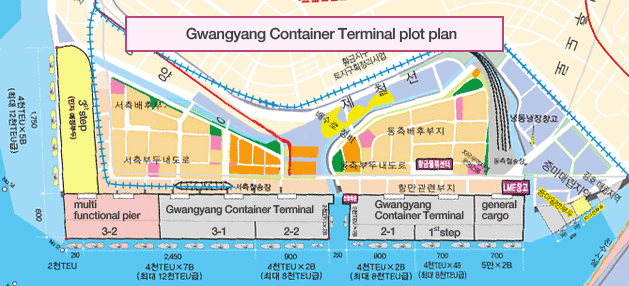Development
Development and Operation
Gwangyang Port's Container Terminal has an advantageous site condition. The adjacent island, Myodo, serves as a natural breakwater and allows the terminal to facilitate cargo working over 360 days a year. This is the only domestic terminal where mega-scale container ships as well as maximum 300,000 ton’s ships can enter and departure thanks to its deep water level (16m). Furthermore, the terminal equips with 100% on dock system and a high-tech crane that enables cargo working for mega carrier level (10,000 TEU or higher) vessels. In addition, its operation based on the advanced IT and the most optimal logistics services by automatic carry in/out service are the envy of the world.

(2012. 12)
| terminal operation company | berthing capacity based on the length of terminal |
Cargo handling capacity | site area (CY area)/ |
equipment ability | CFS | unloading equipment |
|---|---|---|---|---|---|---|
| 3 companies | 4,400m 50,000 x 10 berths 20,000 x 4 berths |
4.6million TEU | 2.326 million m (1.1558 million m) |
247,406TEU | 31.7million㎡ | C/C (25)/ T/C (54) yard tractor (102) Yard chassis(246) reach stacker (14) |
※ Container terminal equipment ability 164,203TEU + Empty container station 83,203TEU
※ remove the 1st and 2nd berth per the change in the port masterplan(‘1212)
Unloading equipment status per container terminal operating companies(2012. 12)
| classification | C/C (Cargo handling capacity) |
T/C (Cargo handling capacity) |
Y/T | chassis | R/S | T/H | forklift truck | |
|---|---|---|---|---|---|---|---|---|
| - (1st step) |
4 | - | - | - | - | - | - | - |
| 18-4 | ||||||||
| HSGT (2-1) |
7 | 15 | 9(4-6) 6(5-6) |
33 | 59 | 4 | 2 | 2 |
| (18-4) (22-3) |
||||||||
| KIT (2-2) |
6 | 18 | 18(5-6) | 25 | 38 | 4 | 2 | 2 |
| (22-6) | ||||||||
| Korea Express Co., Ltd (including steel transportation yard) (3-1) |
8 | 21 | 16(5-6) 5(steel transportation yard) |
44 | 149 | 6 | - | 2 |
| (18-1) (22-7) |
||||||||
| Total | 25 (18-9) (22-16) |
54 | 9(4-6) 40(5-6) 5(steel transportation yard) |
102 | 246 | 14 | 4 | 6 |
(2012. 12)
| Classification | Full | 1stage | 2stage | 3stage | ||||
|---|---|---|---|---|---|---|---|---|
| total | Project Period | '87~'20 | '87~'99 | '95~'01 | '95~'10 | '99~'07 | '03~'20 | '13~'20 |
| Business coverage(berths) Effect (million TEU) |
"Con"21(6.85㎞) 770million TEU |
4 (1.4㎞) 160 |
44 (1.15㎞) 108 |
4 (1.15㎞) 112 |
4 (1.4㎞) 160 |
- multi-functional pier |
5(1.75km) 230 |
|
| Project Cost | 84,669billion | 5,202billion | 12,013billion | 67,454billion | ||||
| Finances | Business coverage | "con" 1(0.28㎞) general terminal 3 (630m) Road 33㎞ Railway 9.6㎞ Arena 80.3㎞ Dredging 89million㎥ Hinterland 643.50000㎡ |
1(0.28㎞) - 6.0㎞ 2.5㎞ - 14million㎥ - |
- - 18.4㎞ - 26.7㎞ 23million㎥ - |
- 630m(3-wire) 8.6㎞ 7.1㎞ 53.8㎞ 52million㎥ 643.50000㎡ (1.95million pyeong) |
|||
| Costs | 40,240billion | 2,289billion | 7,237billion | 30,714billion | ||||
| Private | Project Period(berth) | "con" 20(6.57㎞) | 3(1.12㎞) | 4(1.15㎞) | 4(1.15㎞) | 4(1.4㎞) | -(multi-functional) | 5(1.75km) |
| Other docks9(2,601m) One set of dredging Hinterland 255.50000㎡ |
- - - |
- - - |
2,601m(9berths) One se 255.50000㎡(77pyeong) |
|||||
| Project Period | 44,429billion | 2,913billion | 4,776billion | 36,740billion | ||||
- 3-2. Container terminal construction
- Construction Period: 2002-2011 (substructure work)
(Substructure work: site construction+Apron construction = enabling vessel berthing) - Facility size: 50,000 x 3 berths, 20,000 x 1 berth
- ※Construction to be completed in 2018 according to application of Trigger Rule1
- 1)Trigger Rule: Prepare a master plan per port in advance, and decide when to start construction when logistics volume of the port reaches the prescribed level (trigger point).
- Construction Period: 2002-2011 (substructure work)
- 3-3 Container Terminal Construction
- Construction Period: 2010 - to be completed in 2018 (T/R application)
- Berths: 50,000 tons × 5 berths
- Development by: Gwangyang New Port
- Investment: Approx. KRW 521.7 billion (BTO)
(unit: thousand TEU, %)
| Classification | 2009yea | 2010yea | 2011yea | 2012year | nationwide comparison(%) | comparison to previous year(%) |
|---|---|---|---|---|---|---|
| Total | 16,341 | 19,369 | 21,551 | 22,497 | 100 | 104 |
| Busan Port | 11,980 | 14,194 | 16,175 | 17,023 | 75.6 | 105 |
| Gwangyang Port | 1,810 | 2,087 | 2,064 | 2,148 | 9.5 | 104 |
| Incheon Port | 1,578 | 1,903 | 1,986 | 1,972 | 8.8 | 99 |
| Ulsan Port | 319 | 336 | 323 | 372 | 1.7 | 115 |
| PyeongtaekㆍDangjin Port | 377 | 446 | 522 | 509 | 2.3 | 98 |
| Others | 277 | 412 | 481 | 471 | 2.1 | 98 |
(unit: thousand TEU, %)
| classification | 2008year | 2009year | 2010year | 2011year | 2012year | comparison to previous year(%) |
|
|---|---|---|---|---|---|---|---|
| increase and reduction | rate | ||||||
| Total | 1,810,048 | 1,810,438 | 2,087,890 | 2,064,000 | 2,148,275 | 84,275 | 104.1 |
| import and export | 1,488,090 | 1,478,194 | 1,773,898 | 1,704,000 | 1,816,572 | 112,572 | 106.6 |
| - import | 759,945 | 722,587 | 883,427 | 845,000 | 912,710 | 67,710 | 108.0 |
| - export | 728,145 | 755,607 | 890,471 | 859,000 | 903,862 | 44,862 | 105.2 |
| transshipment | 321,958 | 305,582 | 313,992 | 360,000 | 321,214 | △38,786 | 89.2 |
※Total: Coastal throughput included


